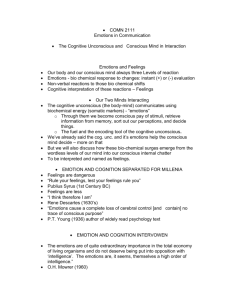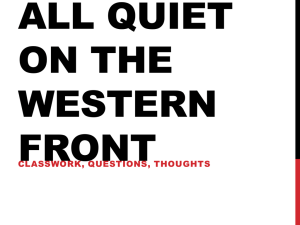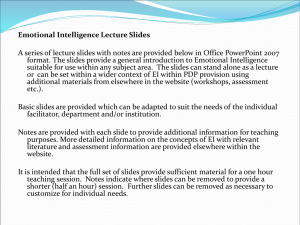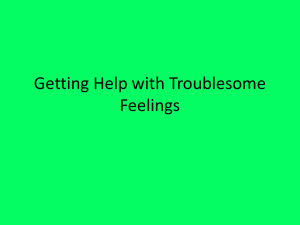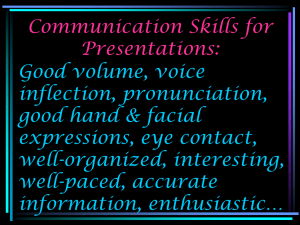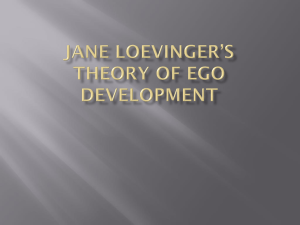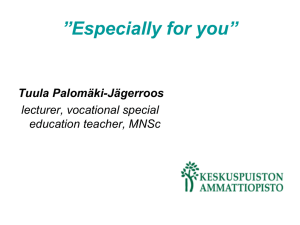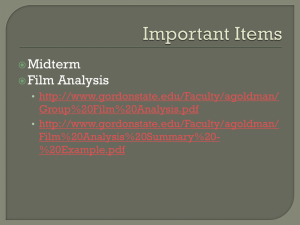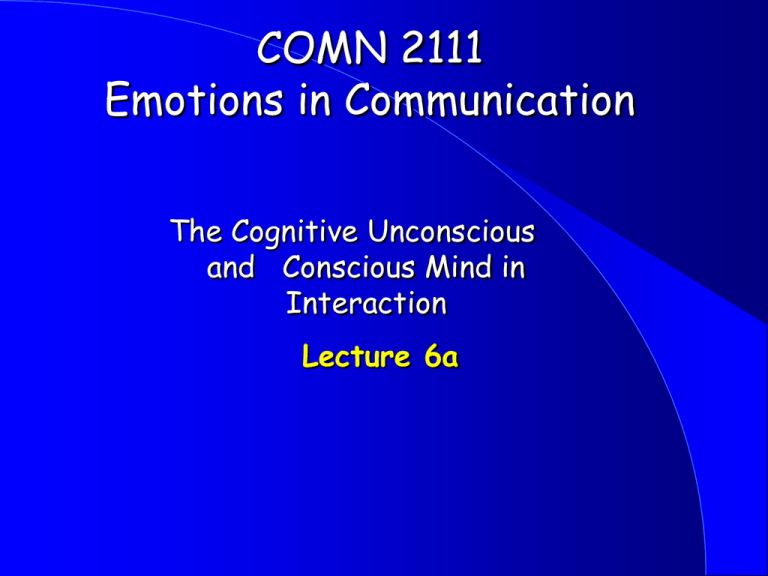
COMN 2111
Emotions in Communication
The Cognitive Unconscious
and Conscious Mind in
Interaction
Lecture 6a
EMOTIONS AND FEELINGS
Our body and our conscious mind always
three Levels of reaction
Emotions - bio chemical response to
changes: instant (+) or (-) evaluation
Non-verbal reactions to those bio
chemical shifts
Cognitive interpretation of these
reactions - Feelings
Our Two Minds Interacting
The cognitive unconscious (the body-mind)
communicates using biochemical energy (somatic
markers) - “emotions”
• Through them we become conscious pay of stimuli,
retrieve information from memory, sort out our
perceptions, and decide things.
• The fuel and the encoding tool of the cognitive
unconscious.
We’ve already said the cog. unc. and it’s emotions
help the conscious mind decide – more on that
But we will also discuss how these bio-chemical
surges emerge from the wordless levels of our
mind into our conscious internal chatter
• To be interpreted and named as feelings.
EMOTION AND COGNITION
SEPARATED FOR MILLENIA
Feelings are dangerous
• “Rule your feelings, lest your feelings rule you”
– Publius Syrus (1st Century BC)
Feelings are less
• “I think therefore I am”
– Rene Descartes (1630’s)
“Emotions cause a complete loss of cerebral
control [and contain] no trace of conscious
purpose”
– P.T. Young (1936) author of widely read
psychology text
EMOTION AND COGNITION
INTERVOWEN
The emotions are of quite extraordinary
importance in the total economy of living
organisms and do not deserve being put into
opposition with ‘intelligence’. The emotions are, it
seems, themselves a high order of intelligence.”
– O.H. Mowrer (1960)
Shifting our Model of Feelings
Our
culture provides us with a
“common sense” model of feeling
awareness.
Something happens in the
environment – context - we notice it
consciously and then respond
physiologically with an emotion.
Schachter’s research changes this in
1960. We had it backwards.
Shifting our Model of Feelings
His hypothesis – our body-mind has an
Affective Appraisal system
• Something happens outside of us and our body
reacts first – a state of Diffuse Physiological
Arousal (DPA)
Then our conscious mind notices and seeks
an answer
Matches our internal state of arousal to
the situation
Names the emotional arousal as a feeling.
• The research story
Real World Research
When we are in a state of DPA not only does our
conscious mind look outward to explain why – but it
finds a self-enhancing reason
The researchers’ hypothesis was that strong emotions
are re-labelled as sexual attraction when two conditions
are met:
(1) an acceptable object is present (a good-looking
female), and
(2) the emotion-producing circumstances do not require
the full attention of the individual – your life is not a
stake.
Real World Research
•A
1974 replication of Schacter
- the conscious mind will use
cues in the external
environment to explain
automatically triggered bodily
sensations
•Experimental Group: The
Capilano Suspension Bridge 450’
long; 287’ above river. Young
men met near the end of bridge
for “interviews”. Hi state of
DPA.
•Control Group: Nearby small
bridge; solid construction only
10” above river. Young men met
near the end of bridge for
“interviews”. Lo state of DPA.
Real World Research
•The
bridge really is high above the
river and it tilts and sways a lot –
worse when many people on it. As I
recently found out.
•When
you come off the bridge your
body feels like it has had way too
much caffeine – red bull high –
buzzing.
•So
what happened? They were met
by a good looking student – doing an
research on the effects of natural
beauty on creativity. Very few
questions then a sketch of a young
woman holding out a hand – and
partly covering her face – write a
story about her.
The “Swinging Bridge” Data
The stories were later scored for manifest sexual
content.
• A story with any mention of sexual intercourse
received 5 points; but if the most sexual reference
was "girl friend," it received a score of 2; "kiss"
counted 3; and "lover," 4.
• On completion of the questionnaire, the interviewer
thanked the subject and offered to explain the
experiment in more detail when she had more time.
Gave name and phone number. Different name for
experimental and control group. It was felt that
differential calling rates might reflect differential
attraction to the interviewer. And level of attraction
related to DPA.
The “Swinging Bridge” Data
Subjects on the swinging bridge expressed double the
amount of sexual content in their “creative” story than
people on the solid bridge.
More of them took her phone number.
And 50% tried to call her – only 12% of the control
subjects called.
They were in full DPA - their conscious brain found a
“logical” answer to it – it must be sexual attraction to
the experimenter – not fear.
Showed in the non-conscious use of sexual imagery about
a neutral picture and in their continuing interest in the
woman.
In Summary: Where Feelings Comes
From
Emotions begin as instant bio-chemical response to
changes in our environment: instant positive or
negative evaluations, which produce,
Rapid bodily reactions to those bio-chemical shifts
(changes of breathing, sweat, muscle tension,
etc.)
The conscious brain – the left frontal lobe’s job is
to match up your internal state with the external
context – to fine cues there to explain and
interpret these reactions
• The external cue it finds and the body’s bio-chemical
reaction may have little or nothing to do with one
another) - “Quick and dirty” match
Feelings and Mood
The conscious mind has named the feeling
and moved on but the bio-chemistry of
body hasn’t
Lingers on as a “mood”
• The sunny day study:
• People called on a sunny day - more positive about their
current state of happiness and life in general than people
contacted on a rainy day.
• People given a small, almost worthless gift, were in a better
mood and gave higher ratings to their household appliances –
when interviewed 50’ later – than others people walking near
them who were stopped and asked at the same time but who
had received nothing.
Feelings and Mood
Bad moods do just the opposite – make
life and other people look more
dangerous.
Our conscious brain has the same
problem as it does with misattributing
arousal …if we haven’t figured out why
we’re in a particular mood…we sometimes
allow that feeling to inform our opinion of
things in general.
Feelings and Mood
Feelings and mood matter mostly when we’re not
paying attention, because when we do notice our
situation, mood doesn’t affect our opinions:
In the mood and weather (sunny day) study:
• When students were casually asked at the beginning
of the conversation – “how’s the weather, there” –
that is, the weather was brought to their
consciousness - they didn’t let it confuse their
thoughts about their state of life.
So we don’t have to be under the automatic
control of our moods- we just need to awaken
to the fact that we are having one.
• Come up with a reason why. Then it no longer shapes
other unrelated thoughts.
Affect Infusion Model (AIM)
Affect- feeling - is most likely to influence
cognition, judgments and decision making when
under pressure:
1.
2.
3.
4.
Decision-maker’s faced with a complex task,
Are motivated to make an accurate judgment,
Ambiguity exists,
A lot of new information needs to be
assimilated
Remember, Damasio’s research on those who
couldn’t decide anything and how first
responders decide in quickly changing situations.
OR WHEN
Affect Infusion Model (AIM)
No pressure at all (most common)
1.
2.
3.
4.
Need to make simple judgments
Lack personal relevance
Low demand for accuracy
Other demands on current information
processing
In the above instances, Decision-makers more
likely to deduce their judgment from their
current affective state - how they feel at the
moment.
The Role of Feelings in Human
Affairs
We now know that feelings influence:
The judgments people make
Material recalled from memory
Attributions for success and failure
Creativity
Inductive and deductive reasoning
The quality our relationships with others
The quality of our communication acts
EMOTION RESEARCH
OVERVIEW
Schachter –1960- new understanding of how
we feel
Dutton – real life –swinging bridgereplication-1974
EMOTION RESEARCH
OVERVIEW
R. Zajonc - emotions shape thought: non-conscious
preference learning -1980.
Reuven Bar-On starts research in 1980 - coins the
term Emotional Intelligence in 1985 - to describe his
approach to assessing emotional competences – to
separate it from measures of IQ
Mayer and Salovey start their work on the potentials
for emotionally intelligent behavior in the 80’s Couldn’t find a mainstream journal to publish their
research in 1990 – 3 three years later – it’s a subdiscipline of psychology.
SO WHY ARE FEELINGS – AND
THE EMOTIONS BEHIND THEM SO POWERFUL?
Daniel Goleman (1995) “Emotional
Intelligence” – described much of the
breakthrough research on emotions of the
80’s and early 90’s and explained the
answer to our question in terms of our
brain’s evolutionary development.
Let’s watch him for a moment.
THE BRAIN’S DEVELOPMENT
Video Example
THE BRAIN’S DEVELOPMENT:
QUICK REVIEW
BRAINSTEM - TOP OF SPINE - AUTOMATIC
FUNCTIONS
LIMBIC SYSTEM - OLDER- FOR PHYSICAL SURVIVAL
- OPERATES QUICKLY - WITHOUT THOUGHT
• CONTAINS AMYDALA - STORES EMOTIONAL
PREFERENCE MEMORIES
• WARN US OF THREAT TO SURVIVAL
NEOCORTEX - PLAN,STRATEGIZE, MORE SLOWLY
CONNECTS THOUGHTS AND FEELINGS
EMOTION AND COGNITION
INTERWOVEN AND IN BALANCE
A. Damasio - “Descartes Error” (1994),
• Emotion and Cognition - Usually balanced necessarily operate in tight harmony
• Emotions inform our thoughts - allow us to
choose - preferences (Zajonc affirmed)
Remember, Goleman said our brains store
our memories in difference places – the
emotional aspect – the somatic markers –in
the amygdala
We will discuss the issue of balance
between the amydala and the frontal lobes
imbalance in our next lecture.
SS 2111
The Other Mind
Lecture 6b
Emotion And Cognition: From
Harmony to Hi-Jack
J. LeDoux, “The Emotional Brain” (1996)
discovered that the Amygdala – the emotional
memory centre of the unconscious brian’s Limbic
System – uses very small bits of info (thin slices)
to assess threat
• And when it perceives one it can “hi-jack” conscious
thought - can take over.
• Leading to Flooding, swamping of our conscious thought
and decision-making processes
D. Goleman – popularizes this idea in 1995 book
“Emotional Intelligence” –he calls it the “amygdala
hi jack”
THE AMYGDALA HIJACK
Video Example
THE AMYGDALA HIJACK
AMYGDALA HIJACK
Uses the biochemistry of fight/flight
CHANGES OF BLOOD CHEMISTRY
BLOOD FLOW
BREATHING
BUT CAN’T DISCRIMINATE BETWEEN “REAL” THREAT AND
SYMBOLIC THREAT
SO WE CAN SAY OR DO THINGS WE REGRET
Think about last time you “lost it” on someone
while you watch this hi-jack from a movie
called “A Few Good Men”
• Is this the way to treat your friends if you’re
having a bad day?
AMYGDALA HIJACK
• Navy lawyer Tom Cruise and two colleagues – one of
whom is Demi Moore are defending two young marinessecretly given an order to harass a fellow marine –they
follow it and while hazing him he dies. They are accused
of murder even though they followed a direct order.
• Tom’s had a bad day. In court Demi Moore made a
mistake – undermined his defense – maked him look
unprepared. Then after court he found out that his key
witness – 2nd in command - has killed himself rather
than tell the truth about the secret order.
• He goes out drinking, comes home hopeless, angry,
frustrated and deeply sarcastic about Demi’s error and
her suggestion that he call the camp commander and
“get out of him” under oath that he gave the order
which the two young men were following.
THE AMYGDALA HIJACK
Video Example
Amygdala Hijack: Summary
Notice that the drinking helps to reduce the control
the left frontal lobe exercise over the amygdala to
maintain balance.
When Demi suggests that he call the camp commander
to the stand – his amygdala screams danger – and you
can see what happened.
This happens in groups too. Group actions act like
alcohol. Consider the Vancouver hockey riot (large
group + alchohol)…the day after many of rioters were
pleading for forgiveness – a left frontal lobe choice –
and unable to explain their “hi jacked” behavior from
the night before – captured on video.
Can We Do Anything to Avoid
This Kind of Imbalance?
Become
more aware of your feelings
as you interact
• Learn to name them and describe them –
give the left frontal lobe a chance
• See Plutchik’s circumplex in text –
simple, clear descriptors of the
essentials
Then
talk them out rather than store
them up and lash out
Can We Do Anything to Avoid
This Kind of Imbalance?
Tell the other exactly what you are feeling.
Identify reasons for your feelings
Tell them why you are feeling the way you are.
• Anchor in the present
• Stay focused on the feelings you are having in this
moment.
• Avoid using “always” and “never” in your descriptions.
• Own your feelings
• Start your sentences with “I” (“I’m feeling …) not “You” as in
(“You made me …”).
• Say what you want the other to do
Can We Do Anything to Avoid This
Kind of Imbalance?
I
promise to give you lots more
information on how to “talk to
yourself” to manage your emotional
reactions in the lectures on selfmanagement at the end of the term.
See you next week.

